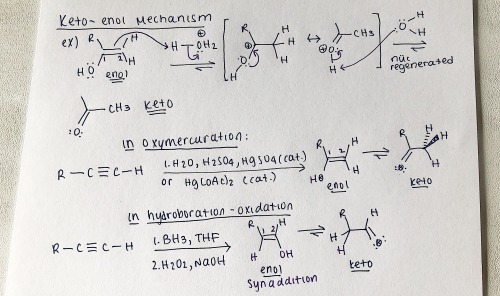Alkyne Hydrogenation: Catalytic Conditions

Hi friends! I finally got around to finishing the notes for this guide today! I would’ve posted yesterday but I was stuck at the hospital for around seven hours, so I was extra exhausted. Lowkey should’ve slept in more haha but it’s all good.
So with these alkyne reactions, a lot of them are just repetitions of the alkene reactions covered in the previous guides. I would definitely refer to the mechanisms in the first guide, since the mechanisms are a lot more structured there. Some of the vocabulary here is reviewed in the second guide as well :)
Alkyne Hydrogenation: Catalytic Conditions

H2, Pd/C is a reagent used in organic reduction and results in with syn hydrogenation
Catalytic conditions refer to how H2, Pd/C is a catalyst
This reagent is used in 2 equivalents, which is why this reaction goes from alkyne to alkane
Alkyne Hydrogenation: Stop at Alkene

Sometimes we don’t want the alkyne to end up as an alkane. Rather, we want the product to be an alkene
That’s where Lindlar’s catalyst comes in, which is “poisoned” to prevent the alkyne from becoming an alkane
Lindlar’s catalyst: Pd/BuSO4, quinoline, CH3OH
H2 and Lindlar’s catalyst prefers syn hydrogenation (aka cis alkene)
To get the trans alkene, just use Na (metal), NH3 (liquid) (or opt for Li metal)
Electrophilic Additions: Addition of HX

HX is used twice to go from alkyne to alkene to alkane (thus excess HX)
X refers to the halogens Br, Cl, and I
This reaction follows Markovnikov’s rule, where X is added to the MORE substituted carbon
The product here is a geminal dihalide: both halogens on the same carbon
Electrophilic Additions: Addition of X2

X2 is added twice to go from alkyne to alkane (thus excess X2)
Note that I2 wouldn’t work here
Markovnikov regioselectivity
Anti stereospecificity (aka anti-addition)
The product here is a vicinal dihalide: halogens on adjacent carbons
Alkyne Hydration: Oxymercuration

Note that we don’t have demercuration in alkyne hydration
The reagents are H2O, H2SO4 with either HgSO4 or Hg(OAc)2 the as catalyst
The product here is shown in the keto form, but in the enol form the OH would attach onto the MORE substituted carbon, thus Markovnikov regiochemistry
Alkyne Hydroboration/ Oxidation

The product has “anti Markovnikov” regiochemistry, because the doubled-bond O attaches onto the LESS substituted carbon in the keto form (in the enol form, the OH attaches onto the less substituted carbon)
The reagents are BH3, THF and H2O2, OH
Keto-Enol Mechanism

Tautomers: structural isomers differing only in the position of an H
Enol and keto forms
Essentially, the OH in the enol form becomes a double-bonded O in the keto form
This is used with H3O+ as the initial electrophile and H2O as the second nucleophile (note that the forms change with the equilibrium reaction)
Resonance structures are formed between the enol and keto forms
The examples featured underneath are condensed mechanisms of the oxymercuration and hydroboration/oxidation reactions featured above. We’re familiar with the enol forms (as seen in the alkene reactions), but the keto forms are drawn more often
Carbon Nucleophiles

With carbon nucleophiles, you’re changing the carbon skeleton of the starting material
The reagents for this are Na+ and NH2- in the solvent NH3 (liquid)
The second step is the tricky part, because you have to come up with a reagent that establishes the new carbon-carbon bond shown in the product
Often times, I usually have to work backwards, meaning that the product is shown, so I need to figure out what that second reagent is
I do this by comparing the starting material and product to see what the new carbon-carbon bond(s) are
Then, I’ll draw the new bond(s) in the second reagent and then add an extra bond with a good leaving group (think SN2 reaction!)
So when the leaving group leaves, the resulting positive charge is attracted to the negative charge of the carbon nucleophile
And BAM, a product with a new carbon skeleton!
It’s so important to number your carbons for these reactions!!
I hope this helped!! And again, please feel free to add more to this and/or make edits if I made a mistake. Thank you!! <3
More Posts from Ohkaydeh and Others
Tips on getting shit done a few days before the exam
Count the number of days left till the exam.
Count the number of topics you need to learn/revise before the exam.
Divide the number of topics by the number of days (you may reserve one or two days for the final revision). This is the amount of work you have to do per day.
Schedule your tasks every day from the time you wake up to the time you go to bed. Try to calculate as realistically as possible the amount of time you would need for each task (I like using Sectograph app for that).
Reserve 1-3 extra hours at the end of every day because you’re not gonna fit everything into the timetable anyway. Believe me.
Don’t forget to schedule some time for rest as well. Once more, be realistic.
Alternate your tasks throughout the day as much as possible. Don’t study the same subject or topic longer than a few hours.
Don’t forget to leave some time for meals, showering, social media and maybe even a film or two.
Just do stuff.
Don’t panic, you’ll get through that.
My Notion Set-Up






(from my IG)
dark academia: stem edition
the sense of roughness creeping onto your fingertips when the ball pen crashes with shabby loose-leaf paper.
the brightness of the laboratory making your eyes aware of something that you wish you could just grab and look at. something more than an idea. you try to wrangle the secrets out of the universe. and your tongue is bitter when you’re asked to leave before your experiment is done.
the stabbing pain that descends upon you when your mind runs off with little fuel, in a direction the yellow pencil in your hand can’t trace. your system is in chaos: you understand what entropy is. you exist, in a state of growing disorder.
the clear sense of belonging that crawls over you when you realize its 12 am and you’re still stuck in the library with nothing to show for but a completed lab report, with diagrams that weren’t required for credit but you couldn’t help but pour over the workings of the pulley with each force labeled to bits. the force of gravity is sinful, you enjoy how it makes the world turn, but sometimes, you wish it would let you fly.
the almost silent moment of calmness that fills your veins when you think of something broken in this world and your hands draw upon your mind like you cannot wait to fill this existing rupture.
you are now a cosmic entity, and your data ignites ideas, and ideas ignite you, and every inch of you can’t help but wonder at what equation you must write and what flowchart you must draft. you are here to correct what must be a slight in the blueprint of the universe.

my sanctum where I study,contemplate and exist ..🏹
dark academia: stem + medicine
math: solving problems in the middle of the night, equations are written on the windowpane, quick calculations in your head, seeing mathematics as a secret language and barrier from the rest of the world, using probability theory to present a person’s life before their very eyes, understanding the algorithms governing every single step of „fate“ and how to manipulate them for your favor, cryptic notebooks, and lost alleyways
engineering: the power to create something that surpasses that is more than humans will ever be, governing and shaping the future of a whole civilization, late-night philosophizing on the nature and difference between humans and machines, crammed study sessions and tired blood-shot eyes
biology: extensive knowledge about herbology and toxicology, knowing almost every plant-based toxin and toxic mushroom in the local area, midnight at the lab with lowlights on and the dark hallways shrouded in mystery, glancing white lab-coats from the corner of your eye
chemistry: spending hours upon hours alone in the lab, perfecting formulas and conducting research because you just know the breakthrough is so close, sudden heureka moments in the middle of the night, inhaling new substances at secret meetings in old buildings to reach a state no human has reached before, prolonged shared eye contact and knowing smiles, the sound of a pen hastingly scribbling chemical formulas into a notebook
physics: „after all, murder is just the redistribution of matter, and matter is my specialty“, pointing out constellations in the sky, seeing patterns no one has seen before, wearing black turtlenecks and long coats while discussing quantum mechanics, hushed whispers, the melancholy of the endless search for another inhabitable planet, coffee cups left on the window sill
comp sci: the sound of typing at lightning speed, a lone screen glowing the absolute dark, losing track of time as you completely lose yourself in your code, trying again and again and again until it finally works, absolute dedication, crafting algorithms that can be used for good – but also for evil, code marathons isolating you from the rest of the world, being able to change lives at the press of a button
medicine: death looms always an inch too close, becoming as natural as life, white coats looming over the dissection table, staring at Rembrandt’s „the anatomy lessons of dr. nicholaes tulp“ in absolute awe, gloves covered in blood, syringes and needles in hand, hollowed laughter, being the last one in the library, knowing too well what sacrifice means




“I wish you to know
that you have been the last dream of my soul.”
—Charles Dickens, A Tale of Two Cities
stem in chaotic academia!!
(science & chemistry focus!)
quickly jotting down calculations with a pen and smearing ink all over your hand
very uneven, unsymmetrical benzene rings
having a used, marked up periodic table hanging by your desk even though you’ve practically memorised it
writing in pen and having to hastily scratch out errors because you have no time for correction tape (youre on the verge of discovery!)
having a favorite element
wearing your lab coat and safety goggles out by accident
chipped black nail polish on trimmed nails with only a choker and stud earrings for jewelry
having a worn out lab notebook, with a scruffed up cover and ink saturating the pages with your scientific knowledge
tacking anatomical diagrams from your textbook on the wall. or even better, drawing your own diagrams
secretly or not so secretly wanting to drink out of a (clean, not used in lab) beaker
taking lab safety seriously but also wanting to digest beautifully colored solutions because pretty
using up so many pens because of how much you write and calculate and document
notes in blue ink, bromophenol blue to be exact
knowing your polyatomic ions, constants, conversions and equations by heart but forgetting to round to the appropriate significant figures
highly corrosive substances
getting used to the smell of methane
treating the lab like your second home
euphoria brought on by being on the brink of discovery
trial, error, success and failure
loving what you do, what you study, and what you learn with all your heart
Having trouble developing the plot of a story? You aren’t alone—this is no small task. But that doesn’t mean it’s impossible. This guide is here to help.
So What Is the Plot of a Story?
Plot is the sequence of events that makes up your story. It’s what compels your reader to either keep turning pages or set your book aside.
Think of Plot as the engine of your novel.
A successful story answers two questions:
1. What happens?
2. What does it mean?
What happens is your Plot.
What it means is your Theme.





my masterpost | my studygram | ask me anything
[click images for high quality]
[transcript under the cut]
Other advice posts that may be of interest:
All About Procrastination
How To Study When You Really Don’t Want To
Common Study Mistakes
7 Strategies to Improve Concentration
Keep reading
-
 ohkaydeh reblogged this · 3 years ago
ohkaydeh reblogged this · 3 years ago -
 ohkaydeh liked this · 3 years ago
ohkaydeh liked this · 3 years ago -
 nocturnalsky28 liked this · 3 years ago
nocturnalsky28 liked this · 3 years ago -
 godsgonegirl liked this · 3 years ago
godsgonegirl liked this · 3 years ago -
 a-chaotic-lesbian-academic liked this · 3 years ago
a-chaotic-lesbian-academic liked this · 3 years ago -
 sofiaxima liked this · 3 years ago
sofiaxima liked this · 3 years ago -
 justexistinguntilgetoldoneback reblogged this · 4 years ago
justexistinguntilgetoldoneback reblogged this · 4 years ago -
 justexistinguntilgetoldoneback liked this · 4 years ago
justexistinguntilgetoldoneback liked this · 4 years ago -
 olddarpellet reblogged this · 4 years ago
olddarpellet reblogged this · 4 years ago -
 denn1s-lessing liked this · 4 years ago
denn1s-lessing liked this · 4 years ago -
 theonlydaecholynne liked this · 4 years ago
theonlydaecholynne liked this · 4 years ago -
 deadpetalstudysphere reblogged this · 4 years ago
deadpetalstudysphere reblogged this · 4 years ago -
 polarisnor liked this · 4 years ago
polarisnor liked this · 4 years ago -
 i-am-your-roof liked this · 4 years ago
i-am-your-roof liked this · 4 years ago -
 ruthlesslistener reblogged this · 4 years ago
ruthlesslistener reblogged this · 4 years ago -
 oatmilk444 liked this · 4 years ago
oatmilk444 liked this · 4 years ago -
 instantflowerdonkeyhands reblogged this · 4 years ago
instantflowerdonkeyhands reblogged this · 4 years ago -
 mujerdelcaleidoscopio liked this · 4 years ago
mujerdelcaleidoscopio liked this · 4 years ago -
 sunshinelearns liked this · 4 years ago
sunshinelearns liked this · 4 years ago -
 mrskarma liked this · 4 years ago
mrskarma liked this · 4 years ago -
 plasmaism liked this · 4 years ago
plasmaism liked this · 4 years ago -
 spikedintheheart liked this · 4 years ago
spikedintheheart liked this · 4 years ago -
 crookedxhermit liked this · 4 years ago
crookedxhermit liked this · 4 years ago -
 delightful-wind liked this · 5 years ago
delightful-wind liked this · 5 years ago -
 chipmunkcomeback liked this · 5 years ago
chipmunkcomeback liked this · 5 years ago -
 icecoldeagle liked this · 5 years ago
icecoldeagle liked this · 5 years ago -
 indie-ginger liked this · 5 years ago
indie-ginger liked this · 5 years ago -
 singingamongthestars-blog reblogged this · 5 years ago
singingamongthestars-blog reblogged this · 5 years ago -
 paintedbeautiful liked this · 5 years ago
paintedbeautiful liked this · 5 years ago -
 benjamin-lpbchem reblogged this · 5 years ago
benjamin-lpbchem reblogged this · 5 years ago -
 pj-halfblood liked this · 6 years ago
pj-halfblood liked this · 6 years ago -
 freshhsalad liked this · 6 years ago
freshhsalad liked this · 6 years ago -
 paralytic liked this · 6 years ago
paralytic liked this · 6 years ago -
 damndemi liked this · 6 years ago
damndemi liked this · 6 years ago -
 minutiaestudies reblogged this · 6 years ago
minutiaestudies reblogged this · 6 years ago -
 yooniversalstudios liked this · 6 years ago
yooniversalstudios liked this · 6 years ago
